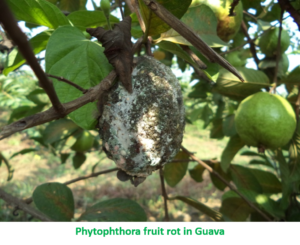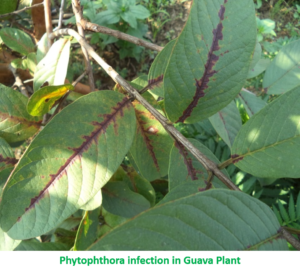< Back to Pest & Disease Management
Phytophthora fruit rot is caused by fungus Phytophthora parasitica.
Symptoms
-
The symptom starts at calyx disc of the fruit during rainy season. Affected area is covered with whitish cotton like growth which develops very fast as the fruit matures and pathogen is able to cover almost the entire surface within a period of 3-4 days during humid weather.
-
Under high relative humidity, the fruits near the soil level covered with dense foliage are most severely affected.
-
The skin of the fruit below the whitish cottony growth becomes a little soft, turns light brown to dark brown and emits a characteristics unpleasant smell ultimately such fruits either remain intact or drop off from the tree.
Mode of spread:
-
Rain and the wind are important for spread.
-
The pathogen produces a great number of sporangia (Spores) on the surface of diseased tissues principally when the temperature is near 25C and this is an important source of inoculums in the development of epidemics.
-
Drops of rain are necessary for the liberation of sponrangia from the infected plant material or soil.
-
Infection ceases when temperature is less than 15C or more than 35
Reason for Severity:
-
Cool, wet environmental conditions with high soil moisture favour disease development.
-
High humidity, temperature from 28-32C, poorly drained soils and injuries are important for initiation of disease.
-
Lack of timely fungicidal sprays.
-
Close plantation. Low interception of light in plant canopy.
Management:
-
Dithane Z-78 (2gms. per liter) or Ridomil or Aliette (2gms) or Copper oxychloride (3gms.) are found effective to control foliar infection.
-
Soil drenching with Copper oxychloride (3gms.) or Ridomil or Aliette (2gms.)
-
Plant spacing and canopy of plant should be managed to avoid unnecessarily dense plant canopy.










